Royal Canadian Air Force
| Royal Canadian Air Force | |
|---|---|
| French: Aviation royale canadienne | |
 | |
| Founded | 1 April 1924 |
| Country | |
| Type | Air force |
| Role | Aerial warfare |
| Size | 391 operational aircraft Personnel: • Regular Force 14,500 Regular force members • Reserve Force: 2,600 Reserve force members • Civilian members: 2,500 civilian members[1] |
| Part of | Canadian Armed Forces |
| Headquarters | National Defence Headquarters, Ottawa, Ontario |
| Motto(s) | Latin: Sic Itur ad Astra "Such is the pathway to the stars"[2] Latin: Per Ardua ad Astra "Through Adversity to the Stars" (1924–1968) |
| March | RCAF March Past |
| Anniversaries | Armed Forces Day (first Sunday of June) |
| Engagements |
|
| Website | www |
| Commanders | |
| Commander-in-Chief | Elizabeth II, Queen of Canada represented by Mary Simon, Governor General of Canada |
| Commander of the Air Force | Lieutenant-General Al Meinzinger |
| Insignia | |
| Roundel |   |
| Fin flash | |
| Ensign |  |
| Aircraft flown | |
| Fighter | CF-18 Hornet |
| Helicopter | CH-139 JetRanger, CH-146 Griffon, CH-147 Chinook, CH-148 Cyclone, CH-149 Cormorant |
| Patrol | CP-140 Aurora, CP-140A Arcturus |
| Reconnaissance | CU-170 Heron |
| Trainer | CT-114 Tutor, CT-142 Dash-8, CT-155 Hawk, CT-156 Harvard II |
| Transport | CC-115 Buffalo, CC-130H Hercules, CC-130J Super Hercules, CC-138 Twin Otter, CC-144 Challenger, CC-150 Polaris, CC-177 Globemaster III, CC-295 Kingfisher |
The Royal Canadian Air Force (RCAF; French: Aviation royale canadienne, ARC) is the air force of Canada. Its role is to "provide the Canadian Forces with relevant, responsive and effective airpower".[3] The RCAF is one of three environmental commands within the unified Canadian Armed Forces. As of 2013, the Royal Canadian Air Force consists of 14,500 Regular Force and 2,600 Primary Reserve personnel, supported by 2,500 civilians, and operates 258 manned aircraft and 9 unmanned aerial vehicles.[1][4] Lieutenant-General Al Meinzinger is the current commander of the Royal Canadian Air Force and chief of the Air Force Staff.[5]
The Royal Canadian Air Force is responsible for all aircraft operations of the Canadian Forces, enforcing the security of Canada's airspace and providing aircraft to support the missions of the Royal Canadian Navy and the Canadian Army. The RCAF is a partner with the United States Air Force in protecting continental airspace under the North American Aerospace Defense Command (NORAD). The RCAF also provides all primary air resources to and is responsible for the National Search and Rescue Program.
The RCAF traces its history to the Canadian Air Force, which was formed in 1920. The Canadian Air Force was granted royal sanction in 1924 by King George V to form the Royal Canadian Air Force. In 1968, the RCAF was amalgamated with the Royal Canadian Navy and the Canadian Army, as part of the unification of the Canadian Forces. Air units were split between several different commands: Air Defence Command (ADC; interceptors), Air Transport Command (ATC; airlift, search and rescue), Mobile Command (tactical fighters, helicopters), Maritime Command (anti-submarine warfare, maritime patrol), as well as Training Command (TC).
In 1975, some commands were dissolved (ADC, ATC, TC), and all air units were placed under a new environmental command called simply Air Command (AIRCOM; French: Commandement aérien). Air Command reverted to its historic name of "Royal Canadian Air Force" in August 2011.[6]
The Royal Canadian Air Force has served in the Second World War, the Korean War, the Persian Gulf War, as well as several United Nations peacekeeping missions and NATO operations. As a NATO member, the force maintained a presence in Europe during the second half of the 20th century.
History[]
1920–1945: Pre-unification[]
The Canadian Air Force (CAF) was established in 1920 as the successor to a short-lived two-squadron Canadian Air Force that was formed during the First World War in Europe. Wing Commander John Scott Williams was tasked in 1921 with organizing the CAF, handing command over later the same year to Air Marshal Lindsay Gordon.[7] The new Canadian Air Force was a branch of the Air Board and was chiefly a training militia that provided refresher training to veteran pilots.[8][9] Many CAF members also worked with the Air Board's Civil Operations Branch on operations that included forestry, surveying and anti-smuggling patrols.[10] In 1923, the CAF became responsible for all flying operations in Canada, including civil aviation. In 1924, the Canadian Air Force, was granted the royal title, becoming the Royal Canadian Air Force (RCAF). Most of its work was civil in nature; however, in the late 1920s the RCAF evolved into more of a military organization. After budget cuts in the early 1930s, the air force began to rebuild.[citation needed]

World War II[]
During the Second World War, the RCAF was a major contributor to the British Commonwealth Air Training Plan and was involved in operations in Great Britain, Europe, the north Atlantic, North Africa, southern Asia, and with home defence. By the end of the war, the RCAF had become the fourth largest allied air force.[11] During WWII the Royal Canadian Air Force was headquartered in 20-23 Lincolns Inn Fields, London. A commemorative plaque can be found on the outside of the building.[citation needed]
1945–1968[]
After the war, the RCAF reduced its strength. Because of the rising Soviet threat to the security of Europe, Canada joined NATO in 1949, and the RCAF established No. 1 Air Division RCAF consisting of four wings with three fighter squadrons each, based in France and West Germany. In 1950, the RCAF became involved with the transport of troops and supplies to the Korean War; however, it did not provide RCAF combat units. Members of the RCAF served in USAF units as exchange officers and several flew in combat. Both auxiliary and regular air defence squadrons were run by Air Defence Command. At the same time, the Pinetree Line, the Mid-Canada Line and the DEW Line radar stations, largely operated by the RCAF, were built across Canada because of the growing Soviet nuclear threat. In 1957, Canada and the United States created the joint North American Air Defense Command (NORAD). Coastal defence and peacekeeping also became priorities during the 1950s and 1960s.[citation needed]
1968–present: Unification[]
In 1968, the Royal Canadian Navy, Royal Canadian Air Force and Canadian Army were amalgamated to form the unified Canadian Forces. This initiative was overseen by then Liberal Defence Minister, Paul Hellyer. The controversial merger maintained several existing organizations and created some new ones: In Europe, No. 1 Air Division, operated Canadair CF-104 Starfighter nuclear strike/attack and reconnaissance under NATO's 4 ATAF; Air Defence Command: operated McDonnell CF-101 Voodoo interceptors, CIM-10 Bomarc missiles and the SAGE radar system within NORAD; Air Transport Command: provided strategic airlift for the NATO and UN Peacekeeping missions; and Training Command. Aviation assets of the Royal Canadian Navy were combined with the RCAF Canadair CP-107 Argus long-range patrol aircraft under Maritime Command. In 1975, the different commands, and the scattered aviation assets, were consolidated under Air Command (AIRCOM).

On 9 November 1984, Canada Post issued "Air Force" as part of the Canadian Forces series. The stamps were designed by Ralph Tibbles, based on an illustration by William Southern. The 32¢ stamps are perforated 12 x 12.5 and were printed by Ashton-Potter Limited.[12] In the early 1990s, Canada provided a detachment of CF-18 Hornets for the air defence mission in Operation Desert Shield. The force performed combat air patrols over operations in Kuwait and Iraq, undertook a number of air-to-ground bombing missions, and, on one occasion, attacked an Iraqi patrol boat in the Persian Gulf.
In the late 1990s, Air Command's CF-18 Hornets took part in the Operation Allied Force in Yugoslavia, and in the 2000s, AIRCOM was heavily involved in the Afghanistan War, transporting troops and assets to Kandahar. Later in the decade-long war, AIRCOM set up a purpose-specific air wing, Joint Task Force Afghanistan Air Wing, equipped with several CH-146 Griffon and CH-147 Chinook helicopters, CC-130 Hercules, CU-161 Sperwer and leased CU-170 Heron UAVs in support of the Canadian Forces and ISAF mission. The wing stood down on 18 August 2011.
From 18 March to 1 November 2011, the RCAF was engaged in Operation Mobile, Canada's contribution to Operation Unified Protector in Libya. Seven CF-18 Hornet fighter aircraft and several other aircraft served under Task Force Libeccio as part of the military intervention.
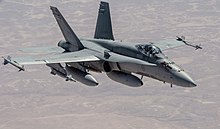
On 16 August 2011, the Government of Canada announced that the name "Air Command" was being changed to the air force's original historic name: Royal Canadian Air Force (along with the change of name of Maritime Command to Royal Canadian Navy and Land Force Command to Canadian Army). The change was made to better reflect Canada's military heritage and align Canada with other key Commonwealth countries whose military units use the royal designation.[13] The RCAF adopted a new badge in 2013, which is similar to the pre-unification RCAF badge (although placed in the modern frame used for command badges). The Latin motto of Air Command – Sic itur ad astra – which was the motto of the Canadian Air Force when first formed after the First World War (before it became the Royal Canadian Air Force in 1924) was retained. Though traditional insignia for the RCAF was restored in 2015, there has been no restoration of the traditional uniforms or rank structure of the historical service (apart from a rank of "Aviator", which replaced that of "Private" in 2015).[14]
On 17 April 2014, Prime Minister Stephen Harper announced that Canada was dispatching six CF-18s and military personnel to assist NATO in operations in Eastern Europe.[15]
Aircraft[]
The Royal Canadian Air Force has about 391 aircraft in service, making it the sixth-largest air force in the Americas, after the United States Air Force, United States Navy, United States Army, United States Marine Corps, and Brazilian Air Force.
Fixed-wing[]
- Airbus CC-150 Polaris
- Airbus A310 transports purchased in 1992 for use as strategic transports and air-to-air tankers to replace the Boeing CC-137. Two have been converted to tankers and are designated the CC-150T. One is permanently configured for VIP transport; five aircraft are operated by 437 Squadron based at 8 Wing Trenton, Ontario.

- Airbus CC-295 Kingfisher[16]
- Twin-turboprop tactical search and rescue aircraft as replacement for the CC-115 Buffalo and older-model C-130H Hercules search and rescue aircraft
- BAE Systems CT-155 Hawk
- Single-engined lead-in fighter trainer leased in 2000. 16 aircraft in service, based at 15 Wing Moose Jaw, SK and 4 Wing Cold Lake, Alberta.
- Beechcraft CT-156 Harvard II
- Single-engined trainer leased from CAE Inc. to replace the Canadair CT-114 Tutor. 24 aircraft based at 15 Wing Moose Jaw, Saskatchewan
- Beechcraft King Air C-90B
- Multi-engine training aircraft. Leased to RCAF by Allied Wings, 7 aircraft are based at Portage la Prairie, Manitoba.
- Boeing CC-177 Globemaster III
- Five strategic airlifters operated by 429 (T) Squadron based at 8 Wing Trenton, Ontario. Four were delivered from 2007 to 2008, a fifth was delivered in 2015.[17]
 An RCAF C-17 Globemaster III at Calgary International Airport
An RCAF C-17 Globemaster III at Calgary International Airport - Bombardier CC-144 Challenger
- Utility and VIP transport aircraft first delivered in 1982. Early Challenger 600 and 601 models were supplemented by 604 models in 2002. Four aircraft are operated by 412(T) Sqn and based in Ottawa, but belong to 8 Wing Trenton.
- Canadair CT-114 Tutor
- Entered service in 1962 as a basic and advanced jet trainer with 190 originally ordered, replaced by the CT-156 Harvard II and CT-155 Hawk in 2000. A total of 26 aircraft remain in service, 24 of which are used by 431 Air Demonstration Squadron, "The Snowbirds".
- DHC CC-115 Buffalo
- A Twin-engined utility/cargo transport now used for search and rescue. Four are operated by 442 Transport and Rescue Sqn. at 19 Wing Comox, British Columbia.
- DHC CC-138 Twin Otter
- A twin-engined utility transport operated since the 1970s, four remain based at Yellowknife, Northwest Territories, operated by 440 Transport Squadron.
- DHC CT-142 Dash 8
- Twin-engined converted regional airliner entered service in 1987 as an aerial navigation and tactics trainer, Four are operated by 402 "City of Winnipeg" Sqn and stationed at 17 Wing, Winnipeg, Manitoba.
- Grob G 120A
- Single engine primary trainer used to train pilot candidates before they move onto the Harvard II. Leased to RCAF by KF Defence Programs, 14 aircraft are based at 3 Canadian Forces Flying Training School in Portage la Prairie, Manitoba.[18]
- Lockheed CC-130H Hercules
- Four-engined tactical transport. Several versions have been operated since 1960. Remaining CC-130Hs used for search and rescue and air-to-air refuelling. 8 aircraft remain in service,[18] five of which have been converted to air-to-air tankers. Based at 14 Wing Greenwood, Nova Scotia, 8 Wing Trenton, Ontario, and 17 Wing, Winnipeg, Manitoba.
 An RCAF CC-130H Hercules on approach to Winnipeg James Richardson International Airport
An RCAF CC-130H Hercules on approach to Winnipeg James Richardson International Airport - Lockheed CP-140 Aurora
- Four-engined maritime patrol aircraft based on the American Lockheed P-3 Orion; entered service in 1980, 18 aircraft now based at 19 Wing Comox, British Columbia, and 14 Wing Greenwood, Nova Scotia.[18]
- Lockheed Martin CC-130J Super Hercules
- Four-engined tactical airlifter replacing earlier Hercules variants in that role.[19] A total of 17 are in service operated by 436 (T) Squadron based at 8 Wing Trenton.[20]
- McDonnell Douglas CF-18 Hornet
- Fighter entered service in 1982 when 98 single-seat CF-18As and 40 two-seat CF-18Bs were ordered. Seventeen have been lost since 1984.[21] Stationed at 3 Wing Bagotville, Quebec and 4 Wing Cold Lake, Alberta; 60 CF-18As and 25 CF-18Bs remain in active service.[18][22]
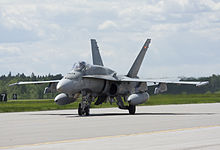 An RCAF CF-18 Hornet during the Bagotville Air Show
An RCAF CF-18 Hornet during the Bagotville Air Show - McDonnell Douglas F/A-18 Hornet (Ex-RAAF)
- 18 have been delivered. Up to seven additional Hornets are also being supplied to be used for spares.[23]
Rotary wing[]
- AgustaWestland CH-149 Cormorant
- Triple-engined search and rescue helicopter that replaced the CH-113 Labrador. Fourteen delivered between 2000 and 2002. Based at (103 Squadron) 9 Wing Gander, Newfoundland; (413 Squadron) 14 Wing Greenwood, Nova Scotia; and (442 Squadron) 19 Wing Comox, British Columbia. One aircraft has been lost in a training accident.
- Bell CH-139 JetRanger (Model C or III)
- Single-engined utility and training helicopter. Ordered for 3 Canadian Forces Flying Training School at CFB Portage la Prairie, MB; an older variant (CH-136 - Jetranger A model), was used by Regular Forces in CFB Lahr in Germany and in Canada from 1972 - 1995 which were replaced by CH-146 Griffons. 12 aircraft remain, leased from Allied Wings, used for flight training in Portage la Prairie, Manitoba.
- Bell CH-146 Griffon
- A utility transport tactical helicopter (UTTH) that entered service between 1995 and 1997. Original purchase of 100 aircraft to replace the CH-136 Kiowa (Bell 206), CH-135 Twin Huey (Bell 212), CH-118 Iroquois (Bell 205), and Boeing C-Model Chinooks CH-47C. Based at Bagotville, Quebec (439 Squadron), St. Hubert, Quebec (438 Squadron), Cold Lake, Alberta (417 Squadron), Gagetown, New Brunswick (403 Squadron), Valcartier, Quebec (430 Squadron), Goose Bay, Newfoundland (444 Squadron), Edmonton, Alberta (408 Squadron), and Borden, Ontario (400 Squadron); also perform search and rescue duties at 8 Wing Trenton (424 Squadron). Deployed to Afghanistan to provide escorts for the Chinooks, armed with a combination of 7.62mm C-6 machine gun, 7.62mm Dillon Aero M134D Gatling gun, and GAU-21 .50 caliber machine gun on one or both doors.[24][25][26] 9 ex-RCAF Griffons, designated CT-146, are leased from Allied Wings for pilot training at Portage la Prairie, Manitoba.
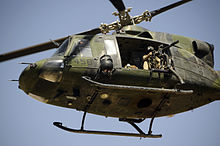
- Boeing CH-147F Chinook
- The CH-147F Chinook is an advanced, multi-mission, medium to heavy-lift helicopter. Its primary mission is the tactical transport of equipment and personnel during domestic or deployed operations. 450 Tactical Helicopter Squadron, under the command of 1 Wing Kingston, Ontario, and based in CFB Petawawa, Ontario, was re-established as the home of Canadaʼs fleet of 15 CH-147F Chinooks. The first two airframes underwent intensive operational test and evaluation in the United States for several months before Canada received the first airframe 147303 at an official acceptance ceremony at the Ottawa International Airport on 27 June 2013.[27][28][29] 15 aircraft are in service as of 2017.[18] Full operational capability by June, 2018.[30] The Auditor General criticized National Defence for "underestimated and understated" the complexity of the purchases of the Chinook, "[t]he way the advance contract notification instrument was applied in the directed procurement of the Chinook helicopters did not comply with the letter or intent of the applicable regulations and policies".[31]
- Sikorsky CH-148 Cyclone
- Ship-based transport/anti-submarine helicopter based on the Sikorsky H-92 Superhawk. Twenty-eight ordered to replace the Sea King from 2009. Delays pushed first delivery to 2015.[18] One aircraft was lost in an accident in April 2020.[32]
 A CH-148 Cyclone in flight
A CH-148 Cyclone in flight
Leased and contractor aircraft[]
The Canadian Forces have leased aircraft from vendors to help transport troops and equipment from Canada and other locations in the past decade. Transport aircraft have been leased as required.
- Beechcraft B300 Super King Air
- Two aircraft leased from Transwest Air Limited. Used by the Multi-Engine Utility Flight (MEUF) in CFB Trenton. Flown by RCAF pilots, they are used for light transport of personnel and equipment within North America.
- Dornier Alpha Jet Type A
- Twelve civil aircraft are operated by Discovery Air Defence Services for CATS (Contracted Airborne Training Services) and are based at CFB Cold Lake and CFB Bagotville
- Hawker Hunter F.58
- Twelve civil aircraft are operated by Lortie Aviation, formerly Northern Lights International Airlines Ltd.. Based in CFB Cold Lake;[33] ex-Swiss Air Force jets
Unmanned Aerial Systems (UAS)[]
RCAF UAS[]
- SAGEM Sperwer
- Designated CU-161; entered service in 2003, retired[34]
- IAI Heron
- 3 leased in 2009 for use in Afghanistan; turned over to the Royal Australian Air Force in 2011[35]
Canadian Army/RCN UAS[]
- BAE Systems Silver Fox
- Acquired in 2004 by the Canadian Forces Experimentation Centre[36]
- Boeing Insitu ScanEagle
- Designated CU-165; operated by the Canadian Army 2008-2014[34]
- Elbit Skylark
- Designated CU-168; operated by the Canadian Army[37]
- AeroVironment RQ-11 Raven
- Operated by the Canadian Army
- AeroVironment RQ-20 Puma
- Acquired in 2018; operated by the Royal Canadian Navy[38]
- Prioria Robotics Maveric
- Operated by the Canadian Army[39]
- Saab Skeldar
- Acquired in 2019; operated by the Royal Canadian Navy and CANSOFCOM[40]
- Boeing Insitu RQ-21 Blackjack
- Designated CU-172; 5 acquired in 2016, operated by the Canadian Army[34][41]
Weapons and other equipment[]
Weapons systems are used by the CF-18 Hornet, CP-140 Aurora, CH-146 Griffon and the CH-148 Cyclone.
| Manufacturer | Origin | Weapon | Type | In Service | Notes |
|---|---|---|---|---|---|
| Lockheed Martin | GBU-10 Paveway II (12, 16 and 24) | Laser-guided bomb | 1980s | Used by CF-18 | |
| General Dynamics | Mark 82 bomb | Low drag general-purpose bomb (500 lb (230 kg)) | 1970s | Used by CF-18 | |
| General Dynamics | Mark 83 bomb | Low drag general-purpose bomb (1,000 lb (450 kg)) | 1980s | Used by CF-18 | |
| General Dynamics | Mark 84 bomb | Low drag general-purpose bomb (2,000 lb (910 kg)) | 1980s | Used by CF-18 | |
| Boeing | Joint Direct Attack Munition[42] | A kit to convert a regular bomb into precision-guided munition | 2011 | Used by CF-18 | |
| Raytheon/Hughes | AGM-65G Maverick Missile | Air-to-surface missile | 1999 leased from the United States for Kosovo Force, 2002 bought by the Canadian Government for the War in Afghanistan (2001-2021)[43] | Used by CF-18 | |
| Bristol | CRV 7 Rocket | Folding-fin ground attack rocket | 1970s | Used by CF-18 | |
| Douglas | AIM-7 Sparrow | Medium-range semi-active radar homing air-to-air missile | 1980s | Used by CF-18 | |
| Raytheon/Hughes | AIM-120 AMRAAM | Beyond Visual Range (BVR) air-to-air missile | 2000s | Used by CF-18 | |
| Raytheon/Ford/ Loral Corp. |
AIM-9 Sidewinder | Heat-seeking, short-range, air-to-air missile | 1980s | Used by CF-18 | |
| General Dynamics/ General Electric |
M61 20mm Vulcan cannon | Air-cooled gatling-style cannon | 1980s | Used by CF-18 | |
| Alliant | Mark 46 torpedo | Air and ship-launched lightweight torpedo | 1970s | Used by CP-140 Aurora and CH-148 Cyclone (but not by CP-140A Arcturus) | |
| FN Herstal | FN MAG C6 | 7.62 mm self-defence machine gun | 1980s | Used by CH-146 Griffon, CH-147F Chinook and CH-148 Cyclone | |
| Dillon Aero | M134 | 7.62 mm self-defence machine gun | 2011 | Used by CH-146 Griffon | |
| Browning Arms Company | M3M | 0.50 cal (12.7 mm) machine gun | 2013 | Used by CH-146 Griffon |
| Manufacturer | Origin | Name | Type | In Service | Notes |
|---|---|---|---|---|---|
| Systems & Electronics, Inc. | 60K Tunner | Material handling equipment | 2008 | Used with CC-177 transport | |
| JBT AeroTech | Halvorsen 44K Loaders | Truck Aircraft Side Load Unload (TASLU) Loader | 2008 | 4 for use with CC-177; licensed from Static Engineering of Australia | |
| Mobile Arrestor Gear | |||||
| FMC Corp. | B-1200 | Aircraft towing tractor | 2008 | Used to tow CC-177 and CC-130 |
Retired weapons[]
| Weapon | Country of manufacture | Type | In service | # |
|---|---|---|---|---|
| CIM-10 Bomarc-B | Supersonic missile equipped with a 10 kt W40 (nuclear warhead) | 1962 to 1972 | N/A | |
| AIR-2 Genie | Air-to-air rocket with a 1.5 kt W25 (nuclear warhead) | 1965 to 1984 | N/A | |
| MK-20 "Rockeye" | Cluster bomb | 1980s to 1997[44] | ≈1000 |
Structure[]

The commander of the Royal Canadian Air Force, located at National Defence Headquarters in Ottawa, commands and provides strategic direction to the Air Force. The commander of 1 Canadian Air Division and Canadian NORAD Region, based in Winnipeg, is responsible for the operational command and control of Royal Canadian Air Force activities throughout Canada and worldwide. The RCAF's other Air Division, 2 Canadian Air Division, was established in June 2009, and consists of training establishments.
There are 13 wings across Canada, 11 operational and 2 used for training. Wings represent the grouping of various squadrons, both operational and support, under a single tactical commander reporting to the operational commander. Ten wings also include a Canadian Forces base along with other operational and support units.
The rank of general is held when an air officer is serving as chief of the Defence Staff. The commander of the Royal Canadian Air Force holds the rank of lieutenant-general. Divisions are commanded by major-generals. Brigadier-generals are typically second-in-command of a division. Wings are commanded by colonels. Squadrons are commanded by lieutenant-colonels. Majors are typically second-in-command of squadrons, or flight commanders. Captains, lieutenants and second lieutenants are the junior level leaders in RCAF squadrons and headquarters.
Ranks[]
Commander-in-Chief[]
| Canada | Commander-in-chief |
|---|---|
| Insignia |  
|
| Title | Commander-in-chief |
| Abbreviation | C-in-C |
Officers[]
| NATO code | OF-10 | OF-9 | OF-8 | OF-7 | OF-6 | OF-5 | OF-4 | OF-3 | OF-2 | OF-1 | OF(D) | Student officer | ||||||||||||||||||||||||
|---|---|---|---|---|---|---|---|---|---|---|---|---|---|---|---|---|---|---|---|---|---|---|---|---|---|---|---|---|---|---|---|---|---|---|---|---|

|

|
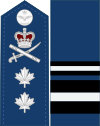
|
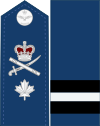
|

|

|

|

|

|

|

|
||||||||||||||||||||||||||
| General | Lieutenant-general | Major-general | Brigadier-general | Colonel | Lieutenant-colonel | Major | Captain | Lieutenant | Second lieutenant | Officer cadet | ||||||||||||||||||||||||||
| Général | Lieutenant-général | Major-général | Brigadier-général | Colonel | Lieutenant-colonel | Major | Capitaine | Lieutenant | Sous-lieutenant | Élève-officier | ||||||||||||||||||||||||||
Non-commissioned members[]
| NATO code | OR-9 | OR-8 | OR-7 | OR-6 | OR-5 | OR-4 | OR-3 | OR-2 | OR-1 | |||||||||||||||||||||||||||
|---|---|---|---|---|---|---|---|---|---|---|---|---|---|---|---|---|---|---|---|---|---|---|---|---|---|---|---|---|---|---|---|---|---|---|---|---|

|

|

|

|

|

|
 |

|

|

|

| ||||||||||||||||||||||||||
| Canadian Forces chief warrant officer |
Command chief warrant officer | Senior appointment chief warrant officer |
Chief warrant officer | Master warrant officer | Warrant officer | Sergeant | Master corporal | Corporal | Aviator (trained) | Aviator (basic) | ||||||||||||||||||||||||||
| Adjudant-chef des Forces canadiennes |
Adjudant-chef du commandement |
Adjudant-chef- nomination supérieure |
Adjudant-chef | Adjudant-maître | Adjudant | Sergent | Caporal-chef | Caporal | Aviateur (formé) | Aviateur (confirmé) | ||||||||||||||||||||||||||
On 1 April 2015, the rank structure and insignia changed.[46] The rank of private was replaced with that of aviator. The previously used term "leading aircraftman" was considered not to be gender neutral.[47] Insignia were also changed from golden yellow to a pearl-grey colour similar to that worn before unification of Canada's armed forces in 1968.[47] A revival of the former rank titles of the RCAF did not occur, however, as such an extensive change was considered "too complicated and confusing".[46] Instead, the current rank titles were retained (with the exception of aviator). The Royal Flying Corps, considered to be a predecessor of the RCAF, used rank titles similar to the existing rank titles of the RCAF.[47]
Symbols[]
Badge[]
The badge of the Royal Canadian Air Force consists of:[48]
- St Edward's Crown
- An eagle superimposed on a circlet
- A compartment of maple leaves
- Motto: Sic Itur Ad Astra (Latin for "Such is the pathway to the stars")
Roundels[]
Roundels used from 1920 until 1945 were usually the same as Royal Air Force roundels although not all variations were used and colours were matched to locally available paints.

1945–1946

1946–1965

Canadian Centennial
1967 variant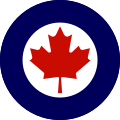
1965–current

Current
low-vis
See also[]
References[]
- ^ Jump up to: a b "Purpose – General Information." Archived 2008-01-17 at archive.today National Defence, 23 April 2008. Retrieved: 2 September 2009.
- ^ "Sic Itur ad Astra – Traditions Motto/Words." Archived 2013-05-22 at the Wayback Machine National Defence, 23 April 2009, Retrieved: 1 April 2013.
- ^ Royal Canadian Air Force. "Royal Canadian Air Force - Mission". Her Majesty the Queen in Right of Canada as represented by the Minister of National Defence. Archived from the original on 6 March 2016. Retrieved 19 March 2016.
- ^ Berthiaume, Lee. "Air force's new name got lost in translation, documents show." Archived 2013-10-17 at the Wayback Machine Postmedia News, 29 November 2011.
- ^ "Royal Canadian Air Force command changes hands - Skies Mag". Skies Mag. Archived from the original on 2018-05-05. Retrieved 2018-05-04.
- ^ "Canadian Forces name." Archived 2011-09-17 at the Wayback Machine CBC. Retrieved: 26 September 2011.
- ^ Associated Press, "R.C.A.F. Founder Taken By Death", The Spokesman-Review, Spokane, Washington, Monday 3 January 1944, Volume 64, Number 134, page 2.
- ^ Roberts, Leslie. There Shall Be Wings. Toronto: Clark, Irwin and Co. Ltd., 1959. No ISBN. p. 33
- ^ Milberry, Larry, ed. Sixty Years—The RCAF and CF Air Command 1924–1984. Toronto: Canav Books, 1984. ISBN 0-9690703-4-9. p. 17
- ^ A History of Air Services in Canada Archived 2014-09-26 at the Wayback Machine Retrieved: 21 May 2014
- ^ Milberry, Larry, ed. Sixty Years—The RCAF and CF Air Command 1924–1984. Toronto: Canav Books, 1984. ISBN 0-9690703-4-9. p. 97
- ^ "Canada Post stamp." Collections Canada. Retrieved: 23 October 2012.
- ^ Galloway, Gloria. "Conservatives to restore ‘royal’ monikers for navy, air force." Archived 2017-02-04 at the Wayback Machine The Globe and Mail, 15 August 2011. Retrieved: 26 September 2011.
- ^ Fitzpatrick, Meagan. "Peter MacKay hails 'royal' renaming of military." Archived 2011-09-24 at the Wayback Machine CBC News, 16 August 2011. Retrieved: 26 September 2011.
- ^ "Canada sending frigate to join NATO in eastern Europe|." Archived 2016-03-11 at the Wayback Machine The Globe and Mail, 1 May 2014.
- ^ "New RCAF search and rescue aircraft to be named "Kingfisher"". Journal Pioneer. Retrieved 2020-09-25.
- ^ Forces, Government of Canada, National Defence and the Canadian Armed (30 March 2015). "Canada News Centre - Archived - Government of Canada Welcomes Increased Air Power for the Royal Canadian Air Force - Canada's Fifth CC-177 Globemaster touches down at 8 Wing Trenton". Archived from the original on 1 April 2015. Retrieved 5 April 2015.
- ^ Jump up to: a b c d e f "World Air Forces 2018". Flightglobal.com. Archived from the original on 2018-02-06. Retrieved 2018-09-04.
- ^ Warwick, Graham. "Canada signs $1.4bn contract for 17 Lockheed Martin C-130Js." Archived 2008-03-10 at the Wayback Machine Flight International, 16 January 2008. Retrieved: 17 January 2008.
- ^ "Canadian Forces CC-130 Hercules." Archived 2011-07-06 at the Wayback Machine Ody.ca . Retrieved: 20 March 2011.
- ^ "CF-18 Hornet in Canadian Service." Archived 2013-09-28 at the Wayback Machine ejection-history.org.uk. Retrieved: 26 September 2011.
- ^ "Canadian CF-18 fighter jets to be kept in use until 2025." Archived 2014-10-04 at the Wayback Machine airrecognition.com, 2 October 2014.
- ^ Andrew McLaughlin (2021-05-13). "Canada receives final ex-RAAF F/A-18A/B Hornets". ADBR. Retrieved 2021-05-14.
- ^ "Dillon Aero 7.62 mm M134 Minigun during exercise near Kandahar." Archived 2011-06-09 at the Wayback Machine The Maple Leaf, Vol. 12, No. 9, 4 March 2009. Retrieved: 26 September 2011.
- ^ "Canada Increases Air Capabilities in Afghanistan." DND/CF News, November 2008. Retrieved: 13 March 2009
- ^ "Griffon at Kandahar."[permanent dead link] airforce.forces.gc.ca. Retrieved: 26 September 2011.
- ^ First CH-147F Chinook helicopter welcomed to Canada Archived 2013-06-28 at the Wayback Machine, National Defence- Royal Canadian Air Force Retrieved: 28 June 2013.
- ^ "Boeing Completes Delivery of Canadian CH-147F Chinooks Transport Helicopter." Archived 2014-07-14 at the Wayback Machine Global News, 2 July 2014.
- ^ "Boeing delivered CH-147F Chinook Maintenance Trainer to the Royal Canadian Air Force." Archived 2015-01-14 at the Wayback Machine Global News, 13 January 2015.
- ^ "CH-147F Chinook procurement project". www.canada.ca. Canada National Defence. 13 December 2018. Retrieved 16 August 2021.
- ^ "FAQ: How Canada procured new military helicopters". CBC. 26 October 2010. Retrieved 16 August 2021.
- ^ "RCAF Cyclone helicopter missing, believed to have crashed into the sea off Greek coast". Ottawa Citizen. Retrieved 2020-11-03.
- ^ "Tactical combat training provided to the armed forces of Canada, France and the United States." Archived 2011-02-07 at the Wayback Machine Lortie Aviation. Retrieved: 26 September 2011.
- ^ Jump up to: a b c "Blackjack: Army hits 21 with new ace in the sky". Canadian Army Today. December 4, 2017. Retrieved August 11, 2021.
- ^ Orr, Conrad Edward (2016). "Can Unmanned Aircraft Systems Meet Canadian Air Power Needs?". RCAF Journal. 5 (3). Retrieved August 11, 2021.
- ^ "Canadian Forces Purchases Mini UAV System". defense-aerospace.com. May 4, 2004. Retrieved August 11, 2021.
- ^ "Canada Selects Skylark as its Future Mini-UAV". Defense Industry Daily. October 6, 2006. Retrieved August 11, 2021.
- ^ "Royal Canadian Navy to Field AeroVironment Puma II AE with Mantis i45 Sensor Aboard Coastal Defence Vessels". Bloomberg. February 28, 2018. Retrieved August 9, 2021.
- ^ Mortimer, Gary (August 15, 2010). "Prioria win Canadian defence contract with Maveric MAV". Suas News. Retrieved August 11, 2021.
- ^ [1][dead link]
- ^ Ruskin, Brett (July 15, 2016). "Canada's new $14.1M fixed-wing drones are runway free". CBC News. Retrieved August 11, 2021.
- ^ "CF-188 Hornets on Op MOBILE drop first JDAM bombs." Archived 2012-03-08 at the Wayback Machine Forces.gc. Retrieved: 2 February 2012.
- ^ "Special Issue of interviews with writers from FrontLine Defense Magazine - 2004."
- ^ "Disposal of Rockeye Cluster Bombs at CFAD Dundurn." National Defence and the Canadian Forces, 27 July 2004. Retrieved: 26 September 2011.
- ^ Jump up to: a b "Ranks and appointment". canada.ca. Government of Canada. Retrieved 28 May 2021.
- ^ Jump up to: a b "New Royal Canadian Air Force uniform unveiled." Archived 2014-09-24 at the Wayback Machine CTV Ottawa1 April 2015.
- ^ Jump up to: a b c "DND Backgrounder." Archived 2014-12-18 at the Wayback Machine news.gc.ca, April 2015.
- ^ "Royal Canadian Air Force". Public Register of Arms, Flags and Banners. Governor General of Canada. Archived from the original on 21 September 2017. Retrieved 4 September 2017.
Further reading[]
- Douglas, W. A. B. The Creation of a National Air Force: Official History of the Royal Canadian Air Force, v. 2. Toronto: University of Toronto Press (in co-operation with the Department of National Defence), 1986. ISBN 0-8020-2584-6.
- Green, William & Swanborough, Gordon (February–May 1979). "A Grumman by Any Other Name...". Air Enthusiast (9): 26–39. ISSN 0143-5450.
- Milberry, Larry, ed. Sixty Years: The RCAF and CF Air Command 1924–1984. Toronto: Canav Books, 1984. ISBN 0-9690703-4-9.
- Piggott, Peter. Flying Canucks: Famous Canadian Aviators. Toronto: Hounslow Press, 1996. ISBN 0-88882-175-1.
- Piggott, Peter. Flying Canucks II: Pioneers of Canadian Aviation. Toronto: Hounslow Press, 1997. ISBN 0-88882-193-X.
External links[]
| Wikimedia Commons has media related to Royal Canadian Air Force. |
- Official website

- Canadian Air Force aircraft and equipment of Canada(Air recognition)
- "Roundel Round-Up" – Vintage Wings of Canada's history of British and Canadian roundel styles from 1914 through and into the 21st century
- The Royal Canadian Air Force in the Arctic and Sub-Arctic Manuscript at Dartmouth College Library
- Royal Canadian Air Force
- Federal departments and agencies of Canada
- 1924 establishments in Canada
- Military units and formations established in 1924
- Organizations based in Canada with royal patronage
- 1968 disestablishments in Canada
- Military units and formations disestablished in 1968














